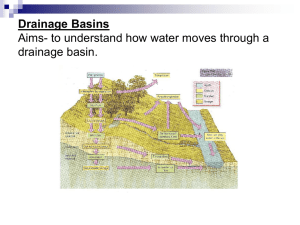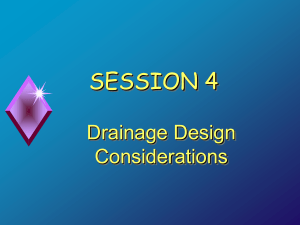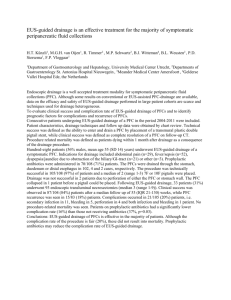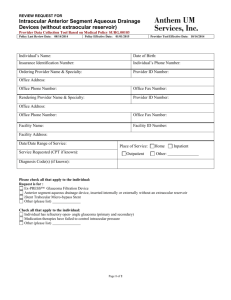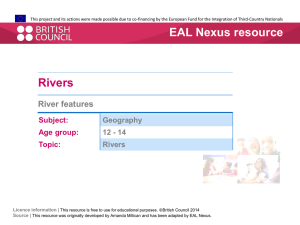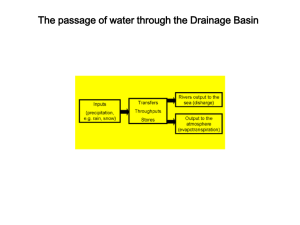Chapter 14 Soil drainage
advertisement
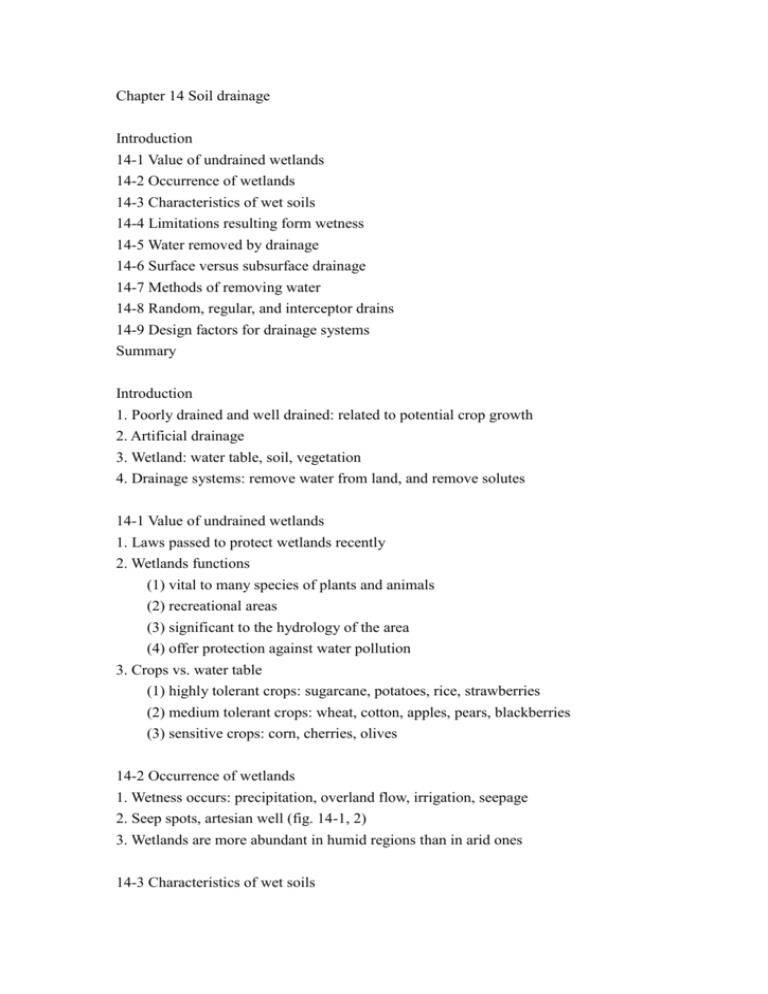
Chapter 14 Soil drainage Introduction 14-1 Value of undrained wetlands 14-2 Occurrence of wetlands 14-3 Characteristics of wet soils 14-4 Limitations resulting form wetness 14-5 Water removed by drainage 14-6 Surface versus subsurface drainage 14-7 Methods of removing water 14-8 Random, regular, and interceptor drains 14-9 Design factors for drainage systems Summary Introduction 1. Poorly drained and well drained: related to potential crop growth 2. Artificial drainage 3. Wetland: water table, soil, vegetation 4. Drainage systems: remove water from land, and remove solutes 14-1 Value of undrained wetlands 1. Laws passed to protect wetlands recently 2. Wetlands functions (1) vital to many species of plants and animals (2) recreational areas (3) significant to the hydrology of the area (4) offer protection against water pollution 3. Crops vs. water table (1) highly tolerant crops: sugarcane, potatoes, rice, strawberries (2) medium tolerant crops: wheat, cotton, apples, pears, blackberries (3) sensitive crops: corn, cherries, olives 14-2 Occurrence of wetlands 1. Wetness occurs: precipitation, overland flow, irrigation, seepage 2. Seep spots, artesian well (fig. 14-1, 2) 3. Wetlands are more abundant in humid regions than in arid ones 14-3 Characteristics of wet soils 1. Colors of wet soils (1) dark: high organic matter in wetland (2) white: salt accumulation in dryland 2. Organic matter in wet soils (1) wet soil accumulate organic matter (2) high fertility and favorable soil structure (3) organic matter will loss gradually 3. Clay in wet soils (1) erosion and weathering increase clay contents (2) clay contributes to higher cation-exchange 4. Reducing conditions in wet soils (1) reducing oxygen, slow microbial activity (2) sulfuric acid formed, pH between 2 and 3 5. Alkalinity in wet soils (1) soluble salts from a saturated zone (2) irrigation add more salt to topsoil (3) evaporation leave salt on soil in arid region 6. Types of alkaline soils (1) water table influences alkaline (fig. 14-3) (2) capillary fringe: 6-8 in thick (3) organic matter to be black soil (4) saline, sodic, and salt-free soils: dryland 7. Saline seeps: (1) summer fallow (2) high precipitation periods (3) poor surface drainage (4) snow accumulation (5) gravelly and sandy soils (6) drainageways (7) constructed ponds and dugouts that leak (8) artesian water flows (9) roadbeds across natural drainage ways (10) crop failure 14-4 Limitations resulting from wetness 1. Physical limitations of wet soils (1) water weakens clay soil strength (2) moistening the sand increase its strength (3) traffic causes soil damage (fig. 14-4) (4) wetness delays tilling and planting (5) wetness causes low soil temperature 2. Chemical effects of wetness (1) wetness causes oxygen deficiencies (2) plant roots need oxygen (3) nutrient deficiencies: K, N (4) denitrification: reduce nitrates to gaseous N (fig. 14-5) (5) change pH value 14-5 Water removed by drainage 1. Soil water classification: (1) unavailable: (2) available: for plant (3) gravitational: drainage removed 2. Field capacity: between available and gravitational, retained by soil (fig. 14-6, 7) 3. Preferential flow: macro pores 14-6 Surface versus subsurface drainage 1. Surface drains: remove excess water that has not had enough time to infiltrate 2. Subsurface drainage: a high water table 14-7 Methods of removing water 1. Land smoothing: filling low places (1) improves both irrigation and drainage (2) improve both surface and subsurface drainage (3) usually requires no maintenance (fig. 14-8) 2. Drainage ditches (1) surface or subsurface drainage (fig. 14-9) (2) ditch gradient vs. drainage (3) ditches are widely spaced, deepened (4) ditch bank maintenance requirement (5) vegetation stabilizes ditch bank (fig. 14-10) 3. Tile drainage (fig. 14-11) (1) for surface and subsurface drainage (2) permits normal equipment and livestock traffic across the field (3) disadvantage: high cost (4) types of tile: clay, concrete, plastic, steel, aluminum, fiber (fig. 14-12) (5) depth and spacing of tile lines: 0.5-2 m depth, 5-40 m length (6) laying tile: trenching machine (fig. 14-13, 14) 4. Other closed drains: covered and concealed (1) tile drains (2) box drains: triangular or rectangular (3) rock drains: place many layers of rock (4) mole drains: unlined channel behind a long shank 5. Bedding systems and mounds (1) bedding system: raised, convex shape (2) mounds: used in swampy areas in Africa 6. Vertical drainage (1) dry well: drainage well, water flows into the well (2) pumped well: expensive to install and operate, to reduce water table 14-8 Random, regular, and interceptor drains 1. Random drains: in rolling topography with small wet areas (fig. 14-15) 2. Regular drainage systems: broad, flat areas 3. Interceptor drains: deep enough to intercept excess water 14-9 Design factors for drainage systems 1. Choosing the type of system (1) based on essential information (2) economics and convenience factors (3) preferences and customs factors 2. Layout of a drainage system (fig. 14-16) (1) drainage coefficient: depth of water to be removed in 24 hours (in/ 24 hr) (Table 14-1) (2) flow velocity and carrying capacity (Table 14-2) 3. Installing a drainage system (1) water can escape without ponding (2) surveying is strongly recommended 4. Water table management (1) provides optimum soil-moisture condition (2) check structure: raise water level in a ditch (3) controlling the water level: reduce nitrate leaching and increase corn yields 5. Maintenance of drainage systems (1) ditches need to be kept free of excess vegetation and debris (2) tile lines need maintenance: tree roots 6. Inadequate drainage systems (1) reasons: soil has lost permeability, new cropping system may be planned (2) need additional tile lines Summary 1. Wetlands: humid climates, high organic matter 2. Limitations from wetness: change soil structure, delay planting, reduce oxygen, denitrification 3. Open ditches, tile lines 4. Land smoothing and bedding systems 5. Dry wells and pumped wells 6. Drainage system: random, regular, interceptor

